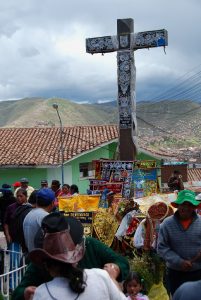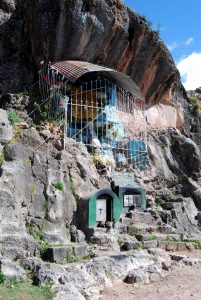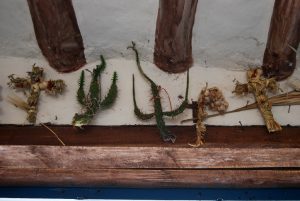The Via Crucis Claims Cuzco

After the big public celebrations of Monday of Holy Week, when the Lord of Temblors enters the city, a different panorama of devotion opens today in Cuzco leading to Easter Sunday. While in the non-liturgical north this may be a time of a now Santa-like Easter Bunny bringing gifts and children getting their picture snapped with an omnipresent rabbit, in Catholic places, like Cuzco, it is more involved.
Undoubtedly this will come to Cuzco, as its mall-culture takes off, thanks to the Arch Bishop, but for now a different ritual reigns. Today, twelve people, children and adults, were chosen to represent the twelve disciples of Jesus in the New Testament. The celebrant of mass washes their feet to bring not commercial culture, but the culture of the time of Jesus and the moments leading up to his crucifixion out of the text and into the lives of the people of Cuzco.
Today people remember the Last Supper when Jesus dined with his disciples and announced Judas and his betrayal. In the Cathedral of Cuzco there is a famous painting of the last supper that illustrates part of this. By the famed eighteenth century Cuzco painter Marcos Zapata it locates the last supper in an Andean landscape. On the table is what many people say is a guinea pig ready to be eaten, although others disagree with that interpretation.

Nevertheless, the painting shows how Christianity took root in different places as if Jesus had lived in Cuzco and held his final supper there. That is how the faithful experience it. The make it part of their world and their lives.
Friday, people accompany Jesus on the Via Crusis, the Way of the Cross. It is the tradition to visit the seven traditional churches. These are San Blas, the Compañia de Jesús, La Merced, San Francisco, San Pedro, La Recoleta, and the Cathedral. They go there to observe the decorations that are made for the occasion and to carry with them the holiness of the death of Jesus. Many people also stay in the Churches praying until it is time to carry out the Via Crucis.


In Cuzco people then gather at the church of La Recoleta where they bring out the cross of the Lord of Tetecaca whose place is near there. They make the climb of the Via Crucis towards Sacsayhuaman.
Not only is this Catholic, but it is also Andean since a Calvary is understood to be a climb up a hill or mountain with the stations of the cross along the way.
As people climb up they remember the 12 stations of the passion and death of Jesus. They stop in different places to be able to read about each station and then to pray the rosary and sing.

When it is almost dawn they arrive at Sacsayhuaman. By the White Christ they finish the path of passion. The cross is placed on a base to sustain it. All the people who accompanied it circle around the cross. The father carries a scourge, a San Martin, to strike the faithful in memory of the whipping that Jesus underwent. People say that in this way they can pay for their sins by helping Jesus to receive the blows.
After this long walk people return home to prepare the twelve traditional dishes, some sweet and some salty.
The Via Crucis is not only carried out in Cuzco but in other districts of the metropolitan area such as in San Sebastian and San Jeronimo. People climb up nearby hills to relive the way of the cross.

Another tradition while making the climb is to look for cactus shaped like a cross. Thorny cactus stems shaped like a cross are sold in the plazas in the days before Good Friday. People buy them to place them above the doors of their houses. There they tend to grow even without there being any water, light, or soil. People say they get their nourishment from the good condition of the family.
Cuzco has a very rich traditional life. Though malls and modern commerce have made their way there, the city still keeps its way that ties Christianity and Andean culture into a single strong chord.





